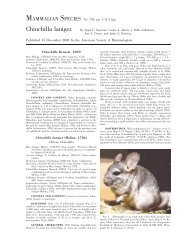Brugia Malayi - Clark Science Center - Smith College
Brugia Malayi - Clark Science Center - Smith College
Brugia Malayi - Clark Science Center - Smith College
You also want an ePaper? Increase the reach of your titles
YUMPU automatically turns print PDFs into web optimized ePapers that Google loves.
What’s Your Orientation: Long PCR Analysis of the Xq28 Region<br />
Cait Kirby<br />
On the XQ28 region of the X chromosome there are two genes flanked by two repeat regions. The orientation of these genes and<br />
repeat regions is variable, with 33% of females presenting as heterozygous. (Small et al) The two genes that exist in this region,<br />
emerin and filamin, serve to produce muscle and structural tissue. If any part of the emerin gene is deleted a patient could have<br />
muscular dystrophy; if any part of the filamin gene is deleted, the embryo is inviable. Emerin, 2kb in length, and filamin, 26kb long,<br />
are sandwiched between two 11.3kb repeat regions which have 99% sequence identity (Small et al). Inversions inhibit recombination<br />
via less frequent crossing over, which contributes to speciation (Small et al).<br />
The goal of this project is to design a teaching lab to provide students with a hands-on learning opportunity to understand<br />
concepts such as crossing over, recombination, and linkage disequilibrium. This teaching lab will also give students an opportunity<br />
to delve into lab work, including DNA extraction, PCR, and gel electrophoresis. In designing this experiment I used information<br />
from scientists at Emory University who provided us with primer sequences, and a PCR program. After determining novel DNA<br />
extraction methods, the PCR began to work, though inconsistently. After deciding to add DMSO (to improve denaturation of G-C<br />
rich regions) and BSA (to bind up inhibitors) both of which are purported to enhance the efficiency of PCR, we became successful,<br />
though still rather inconsistently.<br />
The goal of this project is to produce a presence-absence assay allowing us to quickly and easily determine in which orientation<br />
a student’s genes lie. The primers that we were provided produce two different sized bands, the forward orientation results in an<br />
11kb band, while the inverted orientation results in a 12kb band. The difference is slight, and typically not discernible, but I will still<br />
attempt to multiplex the PCR – putting both assays into one reaction – providing us with one quick answer instead of two separate<br />
reactions. (Supported by the Nancy Kay Holmes Fund)<br />
Advisor: Robert Merritt<br />
References:<br />
Small, Iber & Warren. Emerin deletion reveals a common X-chromosome inversion mediated by inverted repeats. Nat Genet. 1997 May ;16(1):96-9.<br />
2012<br />
34

















